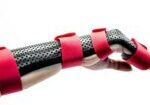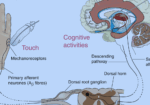A Prospective Randomized Trial Comparing the Functional Results of Buddy Taping Versus Closed Reduction and Cast Immobilization in Patients With Fifth Metacarpal Neck Fractures
Filed under Uncategorized
By: Rachel Reed
Martínez-Catalán, N., Pajares, S., Llanos, L., Mahillo, I., & Calvo, E. (2020). A Prospective Randomized Trial Comparing the Functional Results of Buddy Taping Versus Closed Reduction and Cast Immobilization in Patients With Fifth Metacarpal Neck Fractures. The Journal of hand surgery, S0363-5023(20)30280-X. Advance online publication. https://doi.org/10.1016/j.jhsa.2020.05.013
The Skinny:
The purpose of this randomized controlled trial was to compare functional outcomes of buddy taping to closed reduction and cast immobilization in individuals with fifth metacarpal neck fractures (buddy taping 5th metacarpal fracture). Fifth metacarpal neck fractures are typically treated non-surgically, most often with closed reduction and orthosis immobilization. The authors of this study hypothesized that closed reduction and immobilization would obtain similar clinical results as buddy taping but may slow functional recovery.
In the Weeds:
This study was a prospective, unmasked, controlled randomized clinical trial with 72 participants who had been diagnosed with acute (less than 72 hours) fifth metacarpal neck fractures. The participants were randomly allocated to either Group 1 or Group 2.
Group 1 (34 participants)
- Buddy taping group of the fourth and fifth metacarpals for 3 weeks without reduction of the fracture
- Wrist and fingers were allowed immediate mobilization
Group 2 (38 participants)
- Closed reduction of the fracture and immobilization in an ulnar cast from the proximal interphalangeal (PIP) joint to the forearm
- With the digits in an intrinsic-plus position
The participants were assessed using the Disabilities of the Arm, Shoulder, and Hand (DASH) questionnaire at 3 weeks, 9 weeks, and 1 year. In addition, measurements and data collection regarding range of motion (ROM) of the metacarpophalangeal (MCP) joint, pain, grip strength, return to work, radiographic angulation, and complications was also collected.
After 3 weeks, the participants treated with buddy taping had significantly lower DASH scores than the cast immobilization group. Pain, which was measured with a visual analog scale (VAS), and ROM of the fifth MCP joint was significantly lower in group 1 as well. At 9 weeks, the participants in group 1 also demonstrated better improvements in range of motion and DASH scores than group 2. Group 1 had, on average, 29 fewer days spent off from work than the cast immobilization group. The cast immobilization group had more complications than the buddy tape group, with the most common complications being MCP and PIP joint stiffness, which was present in 9 participants treated with closed reduction and cast immobilization and only 2 participants with buddy taping.
Bringing it Home:
The authors determined that buddy taping and early mobilization had good clinical results as well as significant improvement in time lost from work. The authors concluded that there is no clinical benefit to reduction and orthosis immobilization of fifth metacarpal neck fractures with an initial angulation less than 70 degrees. Despite evidence showing that buddy taping the fourth and fifth digits together yields equivalent (or better) results than closed reduction and immobilization, many doctors and hospitals continue to choose to immobilize fifth metacarpal neck fractures.
Rating:
4/5 – Due to the nature of the interventions in this study, researchers could not be blinded to the control and intervention groups. This study was very thorough and considered both short-term and long-term follow-up with participants. The conclusions drawn by the authors match the results of the data analysis performed, showing a strong, relevant link between buddy taping and improved pain and functional outcomes. This study has the potential to inform and change practice guidelines.
4 Comments
Leave a Comment
More To Read
Scar Management in Hand Therapy
Hand therapists may feel they are in a constant battle with scar tissue. It can limit ROM, cause pain, impede other structures, and leave a less than desirable appearance. Scar tissue starts forming as early as 2 weeks after an injury and can continue forming for up to 2 years. The earlier action is taken…
Read MorePlace-and-Hold Versus Active Mobilization Therapy After Flexor Tendon Repair
Title: Passive Mobilization With Place-and-Hold Versus Active Mobilization Therapy After Flexor Tendon Repair: 5-Year Minimum Follow-Up of a Randomized Controlled Trial Article Review By: Tommi Hintnaus Reference: Chevalley, S., Wangberg, V., Ahlen, M., Stromberg, J., & Bjorkman, A. (2024, October 4). Passive Mobilization With Place-and-Hold Versus Active Mobilization Therapy After Flexor Tendon Repair: 5-Year Minimum…
Read MorePeripheral nerve injury: A hand therapist’s assessment of sensory return.
Sensory return after a hand injury specifically a peripheral nerve injury After a peripheral nerve injury, there are often times impairments in sensory function and/or motor function. The rate of recovery varies based on the degree of injury, the overall health of the patient, and the patient’s age. After an injury, it is important…
Read MoreDart-throwing Angle in Hand Therapy for Scapholunate (SL) Ligament Injuries.
Does Object Height Affect the Dart Throwing Motion Angle During Seated Activities of Daily Living? Cohen, Y., Portnoy, S., Levanon, Y., Friedman, J. (2020). Does object height affect the dart throwers motion angle during seated activities of daily living. Journal of Motor Behavior, (52) 4. Article Review By: Rita Steffes The Skinny: Dart Throwers Motion…
Read MoreSign-up to Get Updates Straight to Your Inbox!
Sign up with us and we will send you regular blog posts on everything hand therapy, notices every time we upload new videos and tutorials, along with handout, protocols, and other useful information.







Ever consider an intrinsic plus splint or an ulnar gutter, remove to perform HEP?
Hello!
Yes we do that commonly in our clinic. This article review just compared the two interventions.
Thanks for the response.
Miranda
What amount of fracture rotation was acceptable
This method makes a lot of sense to me. I noticed on xray, that if you buddy tape to the 4th finger you obtain a neutral alignment in the longitudinal arch. My hand surgeon may consider this as he is already a proponent of early mobilization and progressing ROM early.